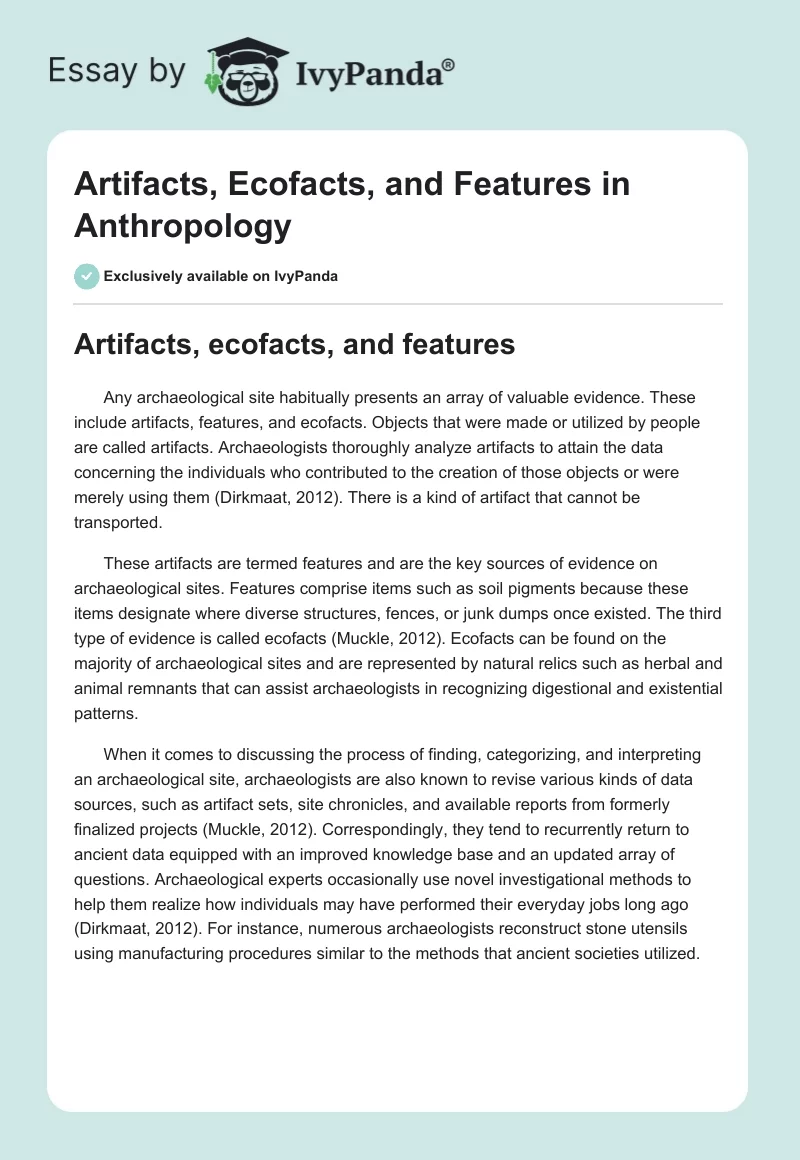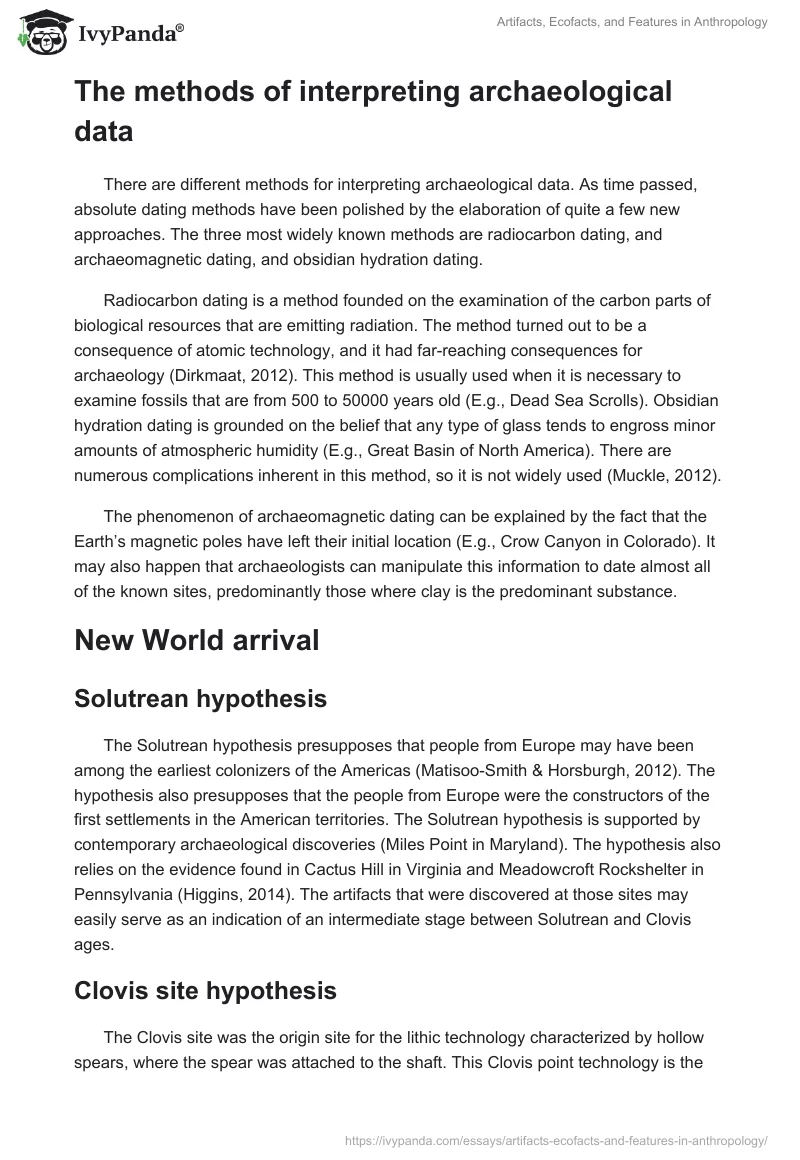Artifacts, ecofacts, and features
Any archaeological site habitually presents an array of valuable evidence. These include artifacts, features, and ecofacts. Objects that were made or utilized by people are called artifacts. Archaeologists thoroughly analyze artifacts to attain the data concerning the individuals who contributed to the creation of those objects or were merely using them (Dirkmaat, 2012). There is a kind of artifact that cannot be transported.
These artifacts are termed features and are the key sources of evidence on archaeological sites. Features comprise items such as soil pigments because these items designate where diverse structures, fences, or junk dumps once existed. The third type of evidence is called ecofacts (Muckle, 2012). Ecofacts can be found on the majority of archaeological sites and are represented by natural relics such as herbal and animal remnants that can assist archaeologists in recognizing digestional and existential patterns.
When it comes to discussing the process of finding, categorizing, and interpreting an archaeological site, archaeologists are also known to revise various kinds of data sources, such as artifact sets, site chronicles, and available reports from formerly finalized projects (Muckle, 2012). Correspondingly, they tend to recurrently return to ancient data equipped with an improved knowledge base and an updated array of questions. Archaeological experts occasionally use novel investigational methods to help them realize how individuals may have performed their everyday jobs long ago (Dirkmaat, 2012). For instance, numerous archaeologists reconstruct stone utensils using manufacturing procedures similar to the methods that ancient societies utilized.
The methods of interpreting archaeological data
There are different methods for interpreting archaeological data. As time passed, absolute dating methods have been polished by the elaboration of quite a few new approaches. The three most widely known methods are radiocarbon dating, and archaeomagnetic dating, and obsidian hydration dating.
Radiocarbon dating is a method founded on the examination of the carbon parts of biological resources that are emitting radiation. The method turned out to be a consequence of atomic technology, and it had far-reaching consequences for archaeology (Dirkmaat, 2012). This method is usually used when it is necessary to examine fossils that are from 500 to 50000 years old (E.g., Dead Sea Scrolls). Obsidian hydration dating is grounded on the belief that any type of glass tends to engross minor amounts of atmospheric humidity (E.g., Great Basin of North America). There are numerous complications inherent in this method, so it is not widely used (Muckle, 2012).
The phenomenon of archaeomagnetic dating can be explained by the fact that the Earth’s magnetic poles have left their initial location (E.g., Crow Canyon in Colorado). It may also happen that archaeologists can manipulate this information to date almost all of the known sites, predominantly those where clay is the predominant substance.
New World arrival
Solutrean hypothesis
The Solutrean hypothesis presupposes that people from Europe may have been among the earliest colonizers of the Americas (Matisoo-Smith & Horsburgh, 2012). The hypothesis also presupposes that the people from Europe were the constructors of the first settlements in the American territories. The Solutrean hypothesis is supported by contemporary archaeological discoveries (Miles Point in Maryland). The hypothesis also relies on the evidence found in Cactus Hill in Virginia and Meadowcroft Rockshelter in Pennsylvania (Higgins, 2014). The artifacts that were discovered at those sites may easily serve as an indication of an intermediate stage between Solutrean and Clovis ages.
Clovis site hypothesis
The Clovis site was the origin site for the lithic technology characterized by hollow spears, where the spear was attached to the shaft. This Clovis point technology is the most prevalent sign of the New World arrival on the territory of North America. The assumption connecting the Clovis site to the New World arrival is contingent on Pleistocene faunal relics which made up the base for the Clovis site hypothesis. The hypothesis proposes that numerous hunters interested in wild animals traveled from Beringia and then spread all over the Americas. This hypothesis is also known as the Clovis First concept.
Non-Clovis lithic artifacts and artifacts of the pre-Clovis ages may be found in the eastern part of North America, even though the age of the artifacts has a tendency to be identified incorrectly (E.g., Meadowcroft, Rock Shelter, and Monte Verde). The hypothesis suggests that the Clovis culture spread from the north to the south of the Americas (Matisoo-Smith & Horsburgh, 2012).
Pacific site hypothesis
Pacific hypothesis presupposes that the nomads first traveled to the Americas by water as they were guided by the Asian coastlines and managed to get to the Americas. This turned out to be a major advantage because coastlines habitually grant access to an assorted selection of vegetation and wildlife from both telluric and aquatic networks (Higgins, 2014). The Pacific migration hypothesis is rather successful in presenting evidence shedding light on how the very first settlers were able to reach tremendously distant locations (considering that Beringia was their starting point). This hypothesis also takes into consideration sites such as and Taima-Taima (Venezuela) and Monte Verde (Chile).
Monte Verde site is important because of the two ethnic artifacts that were found near the Pacific coast of Chile (Higgins, 2014). Nonetheless, the locations associated with the primary immigration are typically waterlogged, so archaeologists are faced with a rather complex task of locating those sites. Also, some types of evidence reliant on the carbon-based substances, including radiocarbon dating, maybe devastated by an excessive amount of liquid and constant underwater pressure.
References
Dirkmaat, D. (2012). A companion to forensic anthropology. Malden, MA: Wiley-Blackwell.
Higgins, N. (2014). Columbus and the journey to the New World. Vero Beach, FL: Rourke Educational Media.
Matisoo-Smith, L., & Horsburgh, K. A. (2012). DNA for archaeologists. Walnut Creek, CA: Left Coast Press.
Muckle, R. (2012). Introducing archaeology (2nd ed.). Peterborough: Broadview Press.


